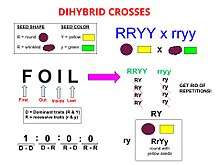Dihybrid cross
Dihybrid cross is a cross between two different lines/genes that differ in two observed traits. In the Mendelian sense, between the alleles of both these loci there is a relationship of complete dominance - recessive. In the example pictured to the right, RRYY/rryy parents result in F1 offspring that are heterozygous for both R and Y (RrYy).[1]

In the name "Dihybrid cross", the "di" indicates that there are two traits involved (e.g. R and Y), the "hybrid" means that each trait has two different alleles (e.g. R and r, or Y and y), and "cross" means that there are two individuals (usually a mother and father) who are combining or "crossing" their genetic information.
The Dihybrid cross is easy to visualize using a Punnett square of dimensions 4 x 4:
| RY | Ry | rY | ry | |
|---|---|---|---|---|
| RY | RRYY | RRYy | RrYY | RrYy |
| Ry | RRYy | RRyy | RrYy | Rryy |
| rY | RrYY | RrYy | rrYY | rrYy |
| ry | RrYy | Rryy | rrYy | rryy |
The rules of meiosis, as they apply to the dihybrid, are codified in Mendel's first law and Mendel's second law, which are also called the Law of Segregation and the Law of Independent Assortment, respectively.
For genes on separate chromosomes, each allele pair showed independent segregation. If the first filial generation (F1 generation) produces four identical offspring, the second filial generation, which occurs by crossing the members of the first filial generation, shows a phenotypic (appearance) ratio of 9:3:3:1, where:
- the 9 represents the proportion of individuals displaying both dominant traits:
RRYY + 2 x RRYy + 2 x RrYY + 4 x RrYy - the first 3 represents the individuals displaying the first dominant trait and the second recessive trait:
RRyy + 2 x Rryy - the second 3 represents those displaying the first recessive trait and second dominant trait:
rrYY + 2 x rrYy - the 1 represents the homozygous, displaying both recessive traits:
rryy
References
- ↑ "The Dihybrid Cross" - Open Door Archived February 7, 2010, at the Wayback Machine.